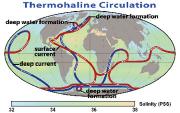Radio Program
Our regular Science and the SeaTM radio program presents marine science topics in an engaging two-minute story format. Our script writers gather ideas for the radio program from the University of Texas Marine Science Institute's researchers and from our very popular college class, Introduction to Oceanography, which we teach to hundreds of non-science majors at The University of Texas at Austin every year. Our radio programs are distributed at to commercial and public radio stations across the country.
Just about everything in the oceans is hunter, hunted, or both. But in the early 20th century, a hunter in the Atlantic turned a fish in the Pacific into one of the most hunted on the planet.
The hunter was the German U-boat. The fishing industry on the East Coast shut down as boats stayed in port to avoid the submarines. So a hungry nation looked to the Pacific Ocean. And there, the fleets brought in a staggering bounty of Pacific sardines.
NEWSREEL: A brilliance of 500 Suns lights hundreds of miles of the Pacific, and the force of a million tons of TNT is released. 15 seconds later, the light is still unbearable.
The nuclear bomb known as Bravo was the most powerful ever exploded by the United States. On March 1st, 1954, the 15-megaton weapon vaporized three islands in the western Pacific. They were part of Bikini atoll -- a ring of islands enclosing a lagoon that’s as big as Chicago. The blast gouged a crater more than a mile wide and 250 feet deep.
Anemones are some of the most beautiful creatures in the sea. Masses of tentacles atop their bodies look like flower petals, waving gently in the currents. And they group together in colonies, spreading color across the ocean floor.
But the tranquil view can be misleading. Colonies can include “warriors” whose job is to keep other colonies from encroaching on their turf. As a result, colonies are separated by narrow strips of open ground -- underwater demilitarized zones.
Like wine, ocean water has its own vintage — in essence, the date it was bottled. Marine scientists determine the vintage by measuring the water’s chemistry. The oldest water mass in the oceans may be almost a thousand years old.
It may be surprising to hear that not all ocean water is alike. The oceans consist of great masses of water. Each mass is determined by its temperature and salinity. It begins to age after it loses contact with the surface.
Scientists determine the age of a water mass by measuring its chemistry.
On warm summer days, the waters around Antarctica can explode in a feeding frenzy. Whales leap from the water, penguins plunge in like black-and-white torpedoes, and birds hover by the thousands. The cause of all this activity is a small creature that’s one of the most important food sources in the oceans: krill.
A new Mars rover is about ready to study an alien landscape. Instead of cold, orange, and dusty, though, this landscape is cold, black, and sludgy — the bottom of Monterey Bay off the coast of California.
The rover is called the Benthic Rover — benthic meaning bottom of the ocean. It’s one of five experiments that’ll be supported by MARS -- the Monterey Accelerated Research System.
A good way to get strong and healthy is to pump iron. And there’s some evidence that pumping a little iron into the oceans could make the environment stronger and healthier, too.
The microscopic plants that float at the top of the oceans, known as phytoplankton, take carbon dioxide that’s entered the ocean from the atmosphere and incorporate it into their bodies. When they die, they sink deeper into the oceans, where they can lock up the carbon for decades or centuries. And some of them fall to the bottom, where the carbon can be locked up for millions of years.
The bottom of most of the Gulf of Mexico is a featureless plain coated with mud. There’s no hard surface for corals or other bottom-dwellers to latch on to. But a few thousand busy habitats do spring from the muddy bottom. They’re like marine versions of high-rise apartments, bustling with life from bottom to top: oil platforms.
Barnacles, mussels, corals, and other shelled creatures attach themselves to the heavy piers and support beams. That attracts fish of all varieties, which in turn attract birds and turtles, establishing a vibrant oasis of life.
They might not look it, but sea urchins are the underwater equivalent of Mongol hordes. Left unchecked, they can strip a kelp forest clean, leaving a barren seafloor that supports little life. That also makes them good markers of an ocean habitat’s health: too many of the spiny little critters means that something is out of whack.
Most sea urchins are no more than a few inches across. They have a hard, dome-like shell that’s covered with spines that can jab your foot if you step on them.
The oceans could someday supply enormous amounts of electricity — and it could be as simple as turning on the hot and cold running water.
The process is called ocean thermal energy conversion. It takes advantage of the fact that at tropical latitudes, there’s a big difference in temperature between water at the surface and a few thousand feet down. The warm surface water can drive turbines, while the cold deep water can keep the cycle going.



